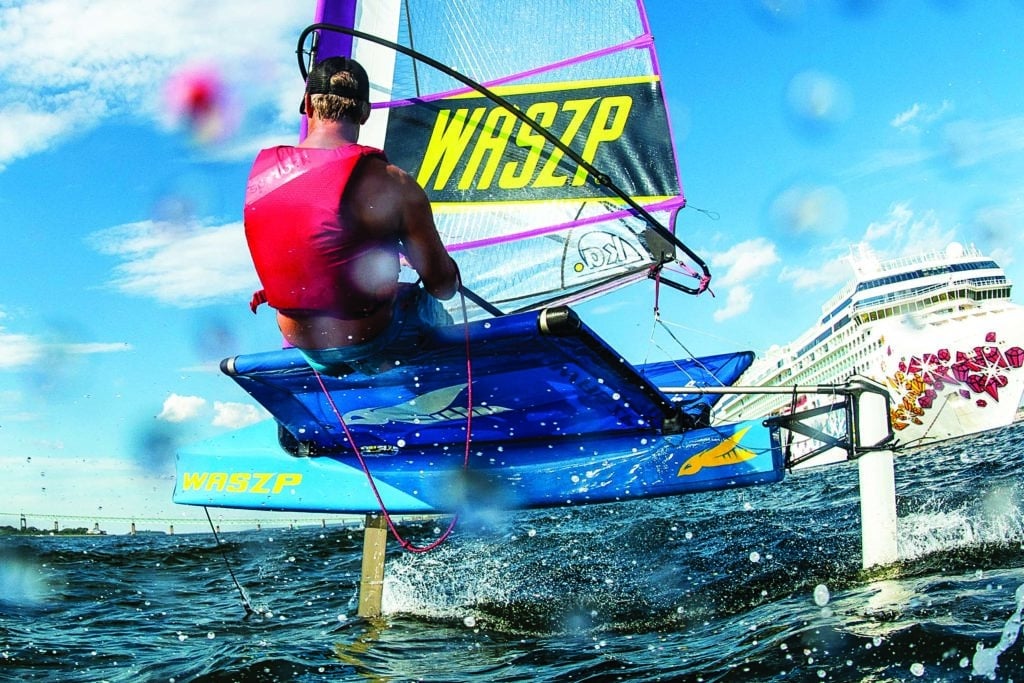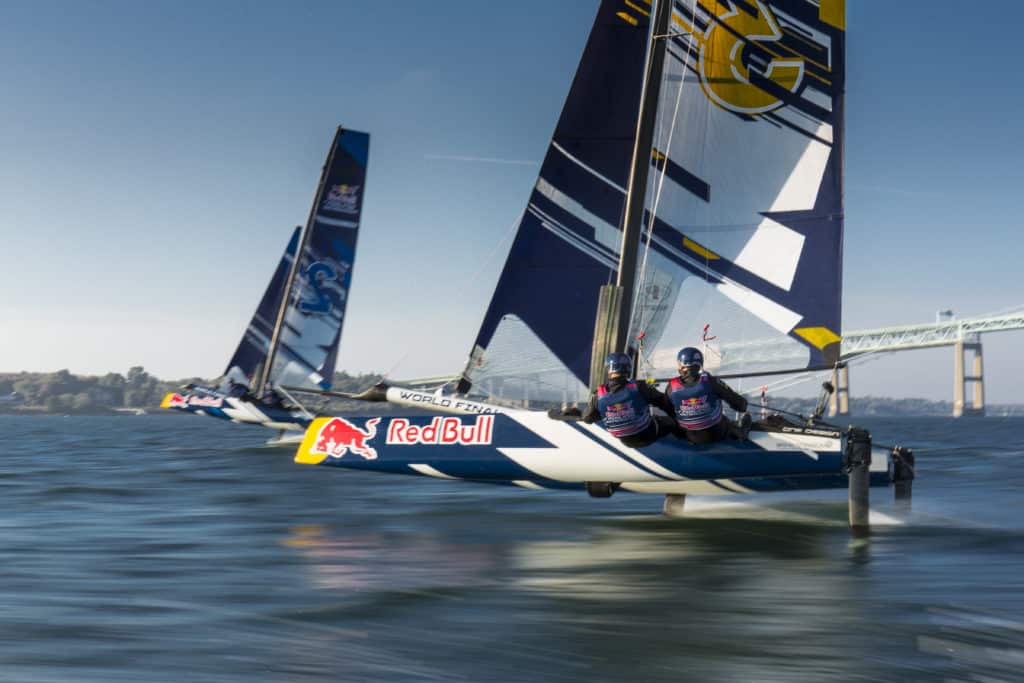
The Waszp’s port wing bar rests on the RIB’s tube, holding the boat steady like a kickstand while I slide in and kneel in the middle of its narrow hull. I reach back for the tiller with my right hand and lean forward to take the mainsheet in my left.
I exhale and then swallow my pride.
Lord, don’t make me look like a fool in front of these guys.
I turn to the gentleman in charge of the Waszp demo, a mop-headed Australian who makes foil sailing look oh so easy and effortless. “Listen,” I say. “I’ve never — ever — foiled. What do I do?”
“No worries,” he responds with a grin. “Just pull on the mainsheet, and once you’re up on the foils, use that to balance the boat.” “Right on,” I say with false bravado. “I got this.”
In this very moment, I have so many other questions swirling in my head, like what am I supposed to do if and when I take flight? How do I turn, stop, not capsize, or accomplish anything but sailing in a straight line?
The answers will come later. As for now, I tension the mainsheet and the RIB slides away. There are no training wheels. The Waszp accelerates, lurches forward, and tips to leeward as righting moment takes over. I clumsily wiggle my body to the wing’s outer tube and pull on more mainsheet. The acceleration again is instant, and so too is liftoff.
The sensation is truly breathtaking as I anticipate the moment when I lose flow on the foils and stuff the bow, as I’ve seen in so many Moth-sailing blooper reels. But the boat is surprisingly stable. My confidence soars. I got this!
I tuck my feet beneath the hiking strap, pull on more mainsheet, lean out to rock the boat to weather, and experience the bliss that is foil sailing: Fast. Silent. Exhilarating.
Dead ahead, however, is a train of steep powerboat wakes, and I brace for the worst. The waves pass beneath my wings with only a hint of a wobble. Now I’m smug. My buddies on the chase boat are witnessing my accomplished flight on my first try, literally within a minute of stepping into the boat. I sail the boat for the better part of an hour, capsizing it every way possible as I experiment with it, and what surprises me most is how easy the Waszp is to right. Waszp creator Andrew McDougall’s proof of concept is right on: This is the foiling singlehander for the masses. If I can do it …
When it’s my turn to give it up for the next customer in line, I do so begrudgingly. While I’m physically exhausted and sloppy after one too many high-speed touchdowns and capsizes, the experience is one I can’t get out of my head. Later, I lie awake in bed, thinking over and over about how I’ll sail it better next time. The addiction to mastering foil-sailing technique, experienced by hundreds before me, is obvious. I get it.
There is a sobering reality to the foiling momentum that’s sweeping into sailing, however. The converted see sailing’s future as foiling, and while that may be so, there’s so much more to learn, and not just about wicked foils and the technical elements that foilers geek out on. There’s the practicality, the safety, the acceptance, and most importantly, foiling’s integration into our traditional sailing landscape, grounded in yacht clubs and windward/leeward races.
These are the weighty considerations put forth to a group of experts assembled at Foiling Week Newport, where the Waszp has made its U.S. debut. It’s a panel that includes entrepreneur Don Montague, who pioneered foiling kiteboards; designer Pete Melvin, who’s working on a project called the Superfoiler (think 18-foot skiff with trapezes mashed with 26-foot foiling trimaran); Andrew McPherson, the brains behind the GC32, who is now developing a 32-foot foiling production catamaran; Brad Read, Foiling Week’s host and executive director of Sail Newport; Matt Knowles, a top Moth sailor and student of the Racing Rules of Sailing; and Bora Gulari, a Moth world champion and Olympic Nacra 17 skipper.

There is serious brainpower in this room to tackle the issues, but after 30 minutes, there are no hard solutions. Safety is one topic that takes center stage. America’s Cup teams have learned their lesson with capsizes in AC72s and 45s, and are all the better because of them, but as rank-and-file sailors begin to play among more experienced foilers, there are far more variables to consider. Gulari, especially, has concerns. Safety is something he thinks about a lot.
“I’m sure we’ll see more people get injured,” he says. “As a sailor, I will always be conscious of which way I’m getting out of the boat in order to get away from the foil. If it goes bad, don’t head up. Instead, bear away and let the boat fall on top of you.”
He also cautions the audience about distractions on racecourses, including drones, coach boats, media boats, spectators and recreational craft. “Sailboats are faster than most powerboats,” he says, “and that changes things.”
Melvin, who is also working on foil packages for the Nacra 17 and Nacra 15 (the latter is the Youth World Championship boat), is well aware of the inherent risk of foils, particularly in the hands of uninitiated youth sailors, but says, “It’s hard to know without more experience with people falling over the side.”
Also fundamental to safety, adds Knowles, is consideration of how foiling races are conducted and how the rules — written for displacement boats with predictable speeds and closing angles — will be applied. The rules so far, he says, scale well to foiling classes, but what concerns him is the future of equipment regulations, including which regulatory body takes it on: World Sailing, classes or event organizers.
It’s not the role of race organizers, says Read. That’s for sure. They’re good at throwing marks in the water but rely on classes to have specific rules and guidelines in place to ensure foiling races go off without a hitch. Read’s bigger fret, as a fan of foiling, is that other organizations won’t want to have anything to do with foiling classes or events because there’s too much risk involved.
Foiling Week is an organization that’s as much an annual regatta and gathering of like-minded sailors as it is a collaboration with the goal of championing constructive dialogue between new foiling classes and individuals who administer the sport. It’s a proactive move to push this emerging counterculture into the sailing mainstream, which is not quite ready or willing to embrace it with open arms.
Now, speaking of open. Somewhere in the excitement of my Waszp-flying experience, I blew out the entire backside of my swim trunks — top to bottom. As I walked back to my truck to change, tattered blue fabric flapping in the wind and my stark white butt cheek exposed for all to see, I could care less. I’d foiled at last, and it felt great. If a bruised backside is the only injury I come away with, then so be it. I’m hooked.









